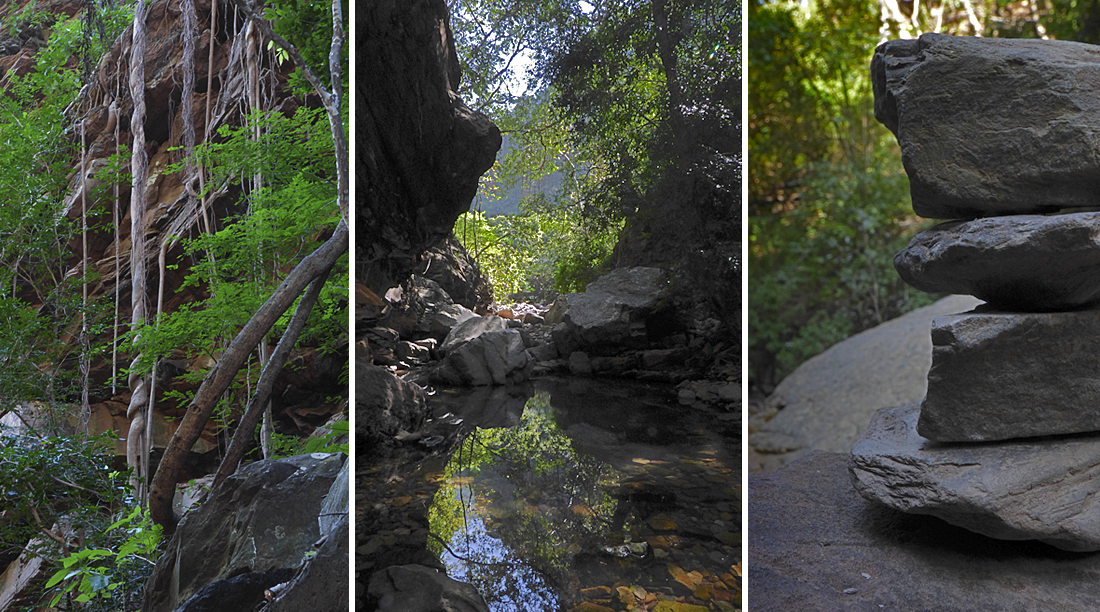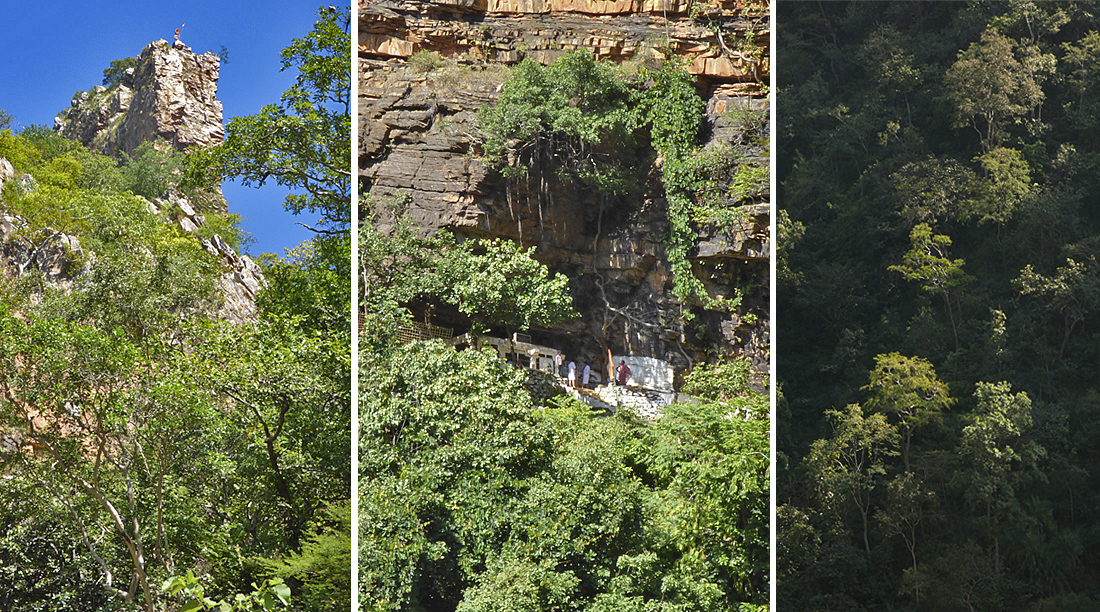This tour has 7 nodes/spots in all. To view each of the spot, please hover the mouse over the thumbnails and click on it in the bottom middle of the tour window. If you wish to view this sopt on the tour map, click on the Map button on the left bottom corner.
The trek to Jwala Narasimha Temple just seems to be tedious, you have to negotiate your way through rocky paths. The 30 minute trek will leave you a little tired, especially if it is a hot day but the silence of the forest and the greenery of the Nallamala hills somehow seem to give you all the energy. Half way up the trek, you will spot the Ugra Sthambham. Though there is well laid stepped path as this is a bit longer, the game and pleasure is here on the path through Bhavanasini river. Jwala Narasimha Swamy Temple is on the edge of a hill, almost like a rock cave temple, when you see it from a distance, it looks
like an opening on the face of the hill.
A waterfall cascades down the hill forming curtain over the narrow pathway leading to the temple and you actually walk betewwn this waterfall and the mountain. There is just a spray of water in December, if you visit this place just after the rains, you will have to walk behind a full fledged waterfall. This waterfall is called the “Akasha Ganga” casting a beautiful rainbow as the sun refracts through the droplets of the waterfall. Along the path, you will find a tiny water hole with muddy coloured water oozing out, it is called the “Rakhta Kundam”, believed to be a pool of water where Lord Narasimha washed his hands after killing Hiranyakasipu and to this day the water oozing out has a reddish tinge. It is believed that the entire area of Ahobilam was actually Hiranyakasipu’s palace and it was at the spot where the temple stood that Lord Narasimha actually killed the demon. Jwala means flame and this is where Lord Narasimha was at the peak of his anger. Frankly, keeping the stories aside, it is the simplicity and serenity of nature around that you really feel presence of theDivine !
JWALA NARASIMHA
The temple of Jwala Nrisimha Swamy, lies higher up the above temple, on a hill called, ‘Achalachaya Meru’. This is about four kilometres from the Upper Ahobilam temple. This place is said to be the actual spot, where the fierce anger of the Lord reached its culmination when he tore Hiranyakasipu.
From Krodha Narasimha Swamy temple the path takes a deviation towards the Jwala Narasimha Swamy temple. Immediately the scenes around changes, in to a thick forest, sunlight struggles to stream in through the tree covers, this coupled with the morning chillness is allways refreshing.The trek to Jwala Narasimha Temple just seems to be tedious, you have to negotiate your way through rocky paths. The 30 minute trek will leave you a little tired, especially if it is a hot day but the silence of the forest and the greenery of the Nallamala hills somehow seem to give you all the energy. Half way up the trek, you will spot the Ugra Sthambham. Though there is well laid stepped path as this is a bit longer, the game and pleasure is here on the path through Bhavanasini river. Jwala Narasimha Swamy Temple is on the edge of a hill, almost like a rock cave temple, when you see it from a distance, it looks
like an opening on the face of the hill.
A waterfall cascades down the hill forming curtain over the narrow pathway leading to the temple and you actually walk betewwn this waterfall and the mountain. There is just a spray of water in December, if you visit this place just after the rains, you will have to walk behind a full fledged waterfall. This waterfall is called the “Akasha Ganga” casting a beautiful rainbow as the sun refracts through the droplets of the waterfall. Along the path, you will find a tiny water hole with muddy coloured water oozing out, it is called the “Rakhta Kundam”, believed to be a pool of water where Lord Narasimha washed his hands after killing Hiranyakasipu and to this day the water oozing out has a reddish tinge. It is believed that the entire area of Ahobilam was actually Hiranyakasipu’s palace and it was at the spot where the temple stood that Lord Narasimha actually killed the demon. Jwala means flame and this is where Lord Narasimha was at the peak of his anger. Frankly, keeping the stories aside, it is the simplicity and serenity of nature around that you really feel presence of theDivine !


